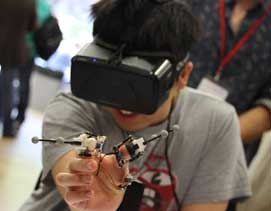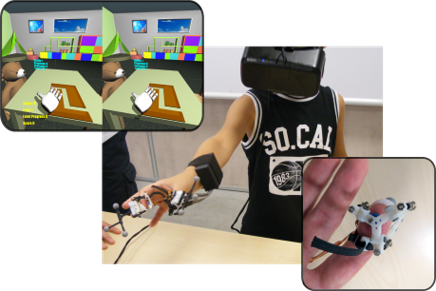
WEARHAP -WEARable HAPtics for humans and robots
Funded from the European Union Seventh Framework Programme FP7/2007-2013 under grant agreement n° 601165. Information and Communication Technologies, Collaborative Large-scale integrating project (IP), FP7-ICT-2011-9-2.1: Cognitive Systems and Robotics. 01.03.2013 — 31.08.2017.
The complexity of the world around us is creating a demand for cognition-enabled interfaces that will simplify and enhance the way we interact with the environment.


Within the Wearhap project, Prof. Frisoli has been the responsible for WP4 on “wearable devices”. Within the project wearable haptic devices conveying tactile feedback at parts of the upper limbs other than fingertips have been devised, exploring 4 dimensions: cutaneous feedback by skin stretch and curvature display, transient information by dynamic stimulation and thermal feedback.

Fingertip haptic device
New Version of the Fingertip Device for rendering interaction forces (skin stretch) and contact transition
- More compact actuators
- New spherical and revolute joints (improving stiffness and precision)
- Multi-finger configuration
- Wireless version (battery at the wrist) under test
- Size: 18x30x32 mm
- Mass: 18 grams
- Displacement (max): +-4mm
- Force (max): 3N


Reference: D. Leonardis, M. Solazzi, I. Bortone and A. Frisoli, “A 3-RSR Haptic Wearable Device for Rendering Fingertip Contact Forces,” in IEEE Transactions on Haptics, vol. 10, no. 3, pp. 305-316, 1 July-Sept. 2017.
doi: 10.1109/TOH.2016.2640291 [pdf]
Pacchierotti, C., Sinclair, S., Solazzi, M., Frisoli, A., Hayward, V., & Prattichizzo, D. (2017). Wearable haptic systems for the fingertip and the hand: taxonomy, review, and perspectives. IEEE transactions on haptics, 10(4), 580-600. [pdf]
Virtual rehabilitation with fingertip haptics in developmental age
Scientific goals
Children with neuro motor disorders (Cerebral Palsy (CP) and Developmental Dyspraxia (DD)) show difficulties in:
- Motor planning and execution
- Understand movements and body limits
- Proprioception and sensory afferents from interaction with the environment
The therapeutic intervention was based on:
- Motor tasks requiring motor planning and coordination
- Repetition of targeted motor tasks (brain plasticity)
- Enhance proprioception and sensory-motor functions (tactile and visual feedback during interaction)
The rehabilitation game scenario
A gaming scenario was developed consisting of two rehab serious games:
- The game scenario presents a groove shaped like a labyrinth that is displayed to the user through a head mounted display. The child wears on his/her finger a cutaneous device, the 3-dof prototype by SSSA, that can exert and modulate forces at the level of the fingerpad
- The scenario exercises different manipulation and movement abilities, in particular for what concerns upper limb orientation and wrist pronation – supination. The child wears the fingertip devices with two fingers in order to be able to perform grasping with thumb and index. The scenario will exercise different manipulation and movement abilities, in particular for what concerns upper limb orientation and wrist pronation – supination. The child wears the fingertip devices with two fingers in order to be able to perform grasping with thumb and index



